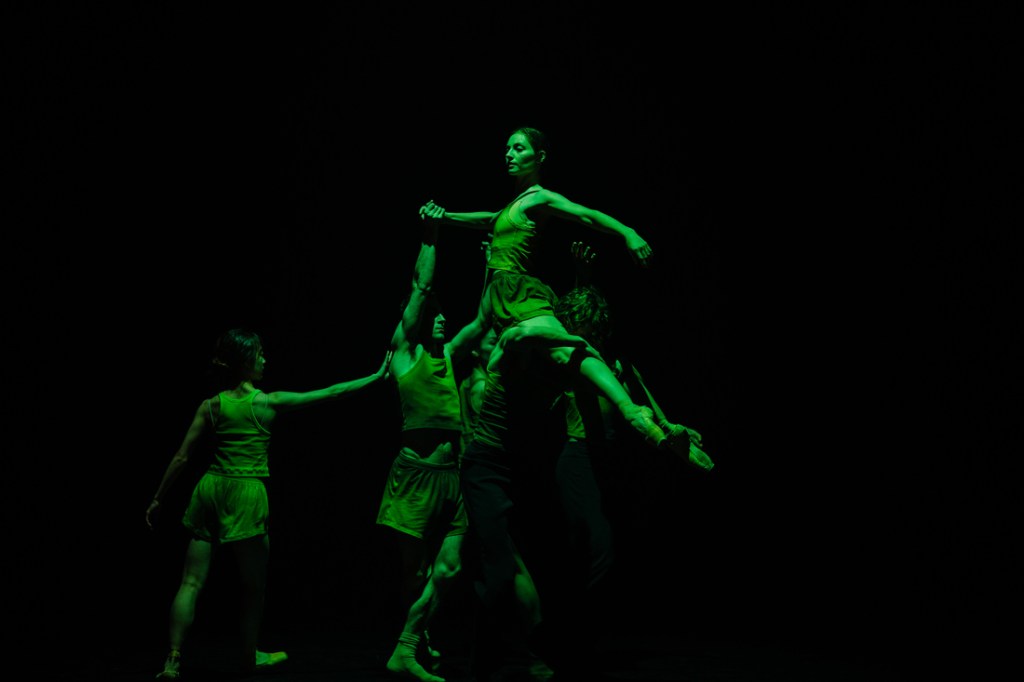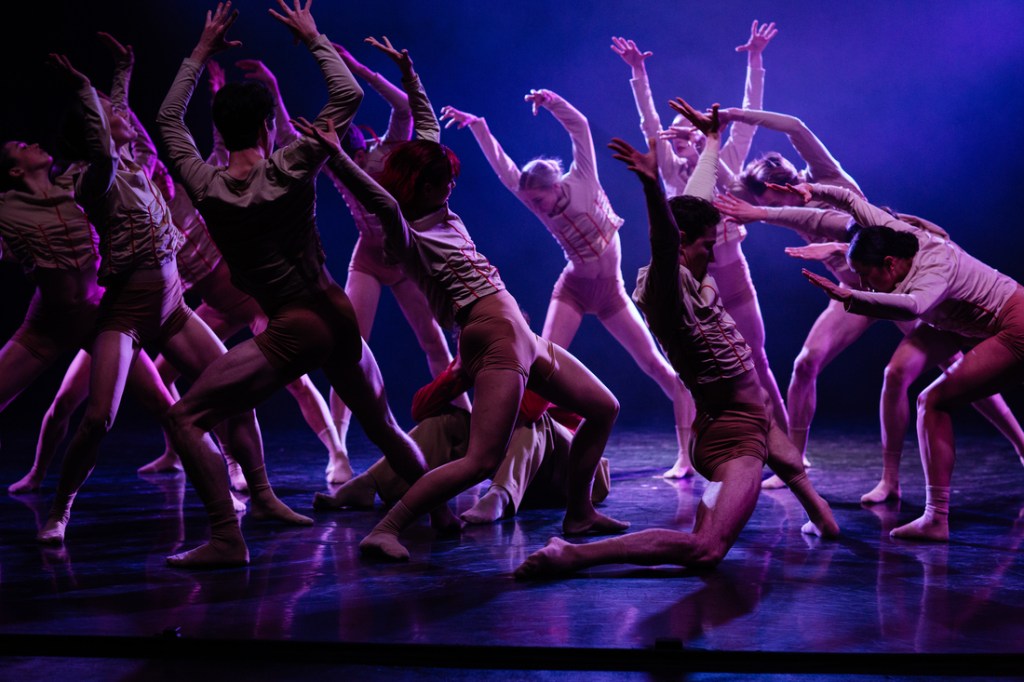Bodytorque, an annual program of emerging choreography performed by dancers of The Australian Ballet, has been a highlight of the Australian dance scene for several years. Last year it was brought to an online platform Bodytorque Digital owing to pandemic restrictions on live performance. This year, opening night celebrated the return of the program to the stage, under the brilliance of a supermoon.
‘Tonight we see the seed of an idea being planted,’ said Artistic Director David Hallberg to the audience before the first piece. ‘There is a sense of vulnerability in making choreography that I personally have never had the guts to pursue,’ he added with humility. And Bodytorque certainly served as a fascinating display of the richness of human experience, expressed through some of the finest, most skilled dancing bodies on Australian stages in this moment.
Many beautiful bodies and resplendent ideas collected in the Brunswick black-box space of Transit Dance. The program, though detailed in a beautiful matte flyer displaying photographs of Australian Ballet dancers Callum Linnane and Dimity Azoury, was not easy to follow and I had to check the running order following the event.
Perhaps leaving the pieces unannounced prior to performance was designed to stir a sense of mystery? It certainly worked, as I did detective work, looking at the assemblage of musicians according to the program and matching those entering the stage at the start of each act. Some of the blurbs were a giveaway but others were enigmatic. Either way, an air of mystery and serendipity was cast over the night that was unexpected, yet in a manner that’s a trademark of Hallberg’s artistic direction at The Australian Ballet.
As for the pieces, each had individual merit and collectively they were a wonderful display of emerging choreographers ‘putting their best feet and ideas forward’, as Hallberg quipped.
Jill Ogai’s opening act, In Time, was a simply gorgeous spectacle. Separated into two sections, the first section saw the dancers moving discordantly to Rosa Clifford’s contemporary track Line of a consistent Hue, rushing past each other, their arms distal from their bodies like signalmen, at times barely touching each other, then making contact with different body parts, then instantaneously falling away.

The glockenspiel combined with viola and cello added to the volatility of this part. Outstanding in this performance was the craftsmanship of Bendicte Bemet, in flowing blue culottes, whose consummate énveloppés and arabesques, showed off her flexibility and magnificence of her lines. Towards the culmination of the piece, the strip lights at the base of the dry misted stage glowed like a train through the fog and Bach’s Cello Suite No. 1 in G major started up.
The dancers went into swaying pas de deux with lush grand allegro, punctuated with spirited accents such as kisses on the cheek, wobbling heads and levelling hands, reminiscent of a railway scene perhaps and ending in the most elegant tumbling off stage all in opposite directions I have ever seen, following tricky balances and suspension of dance partners. Ogai achieved the depiction of ‘dystopian and expansive lines’ mentioned in her artist’s statement to breathtaking closure.
ANGEL//ALIEN, choreographed by Mason Lovegrove, similarly highlighted the acrobatic perfection of the dancers with striking vaults and catches in pas de deux. There was one section where a dancer was thrown in the air backwards over the shoulders of two of the male dancers and caught by another behind. The fragile, butterfly-like accents of the hands at the beginning and end and cocoon silk style costuming, belied the strength and athleticism of the dancers. The conclusion of this piece, with the ensemble holding their fluttering hands up to the light was expressive of wonderment, beautifully distilled in the moment.
Pura Vida by Xanthe Geeves, winner of the 2020 Emerging Female Choreographer award from Dance Australia, created a rambunctious and bright work to the music of Luigi Boccherini. The progression of the piece followed the stages of life, its joys and unexpected obstacles, as the dancers bounded across the stage and rolled over the floor with finesse. The flouncy carriage of the arms and jauntiness of the hips and legs reminded me a little of Roland Petit’s Carmen, as the dancers in gold leotards shimmered under the lights.
One Person Watching, a blend of spoken word and dance by Timothy Coleman, explored the moments we feel alone or connected and the friction between the two. There was a large projection of a window pane on the floor, as principal dancer Callum Linnane riled and paced around the stage, observed by a closing-in crowd of neighbours, watching him through the window. Snatches of the repeated refrain ‘For the first time, always,’ were heard while the dancers swayed in and out of the light to the unnerving movements of Linnane. With a poem in the program as an artist statement, I feel this piece had more to say in further iterations and development, but it was striking in its originality using dialogue and dance to dramatic effect.
Read: Dance review: Terrain
In Ex Celsius, by Serena Graham, cited Einstein’s theory of energy; that it can be neither created nor destroyed, only changed from one form to another. The costumes were stylish in monochrome: white corset tops and black leotard bottoms, with volcanic red hair clips for the female corps de ballet and white singlets and black leggings for the men. What ensued was a tousle between forces, meticulously articulated in footwork and balances as the dancers stood in tight fifth position and fell outwards, domino-like into a plucky Mazurkaesque fast dance with clapping accents.
The last performance and perhaps the most sharp-toothed (or footed) of the six, was KIDS THESE DAYS choreographed by Benjamin Garrett. The piece focused on ‘the frustrations, rage and hopelessness’ felt by Garrett’s generation and assuredly exuded these things through clever dance vocabulary and stage craft. The music and lighting was extreme, with ‘heavy club vibes’ and the dancers showed off their virtuosity far beyond classical ballet, with waacking and breakdancing involving expert drop splits and body rolls. At one point I wanted to scream ‘Ballerinas in a dance club, hell yeah!’, but of course, I didn’t. The freedom and confidence of this piece was intoxicating and a high note to end on.
The variety of the bill, freshness of ideas and utter physical prowess of the dancers yet again placed The Australian Ballet smack bang at the epicentre of experimental, exciting and going-places dance. A triumph of a showcase and a tantalising reminder of where commitment to new ideas can take ballet companies.
Bodytorque
The Australian Ballet
Transit Dance Theatre, Brunswick, Melbourne
Bodytorque was performed from 11-13 August 2022.





